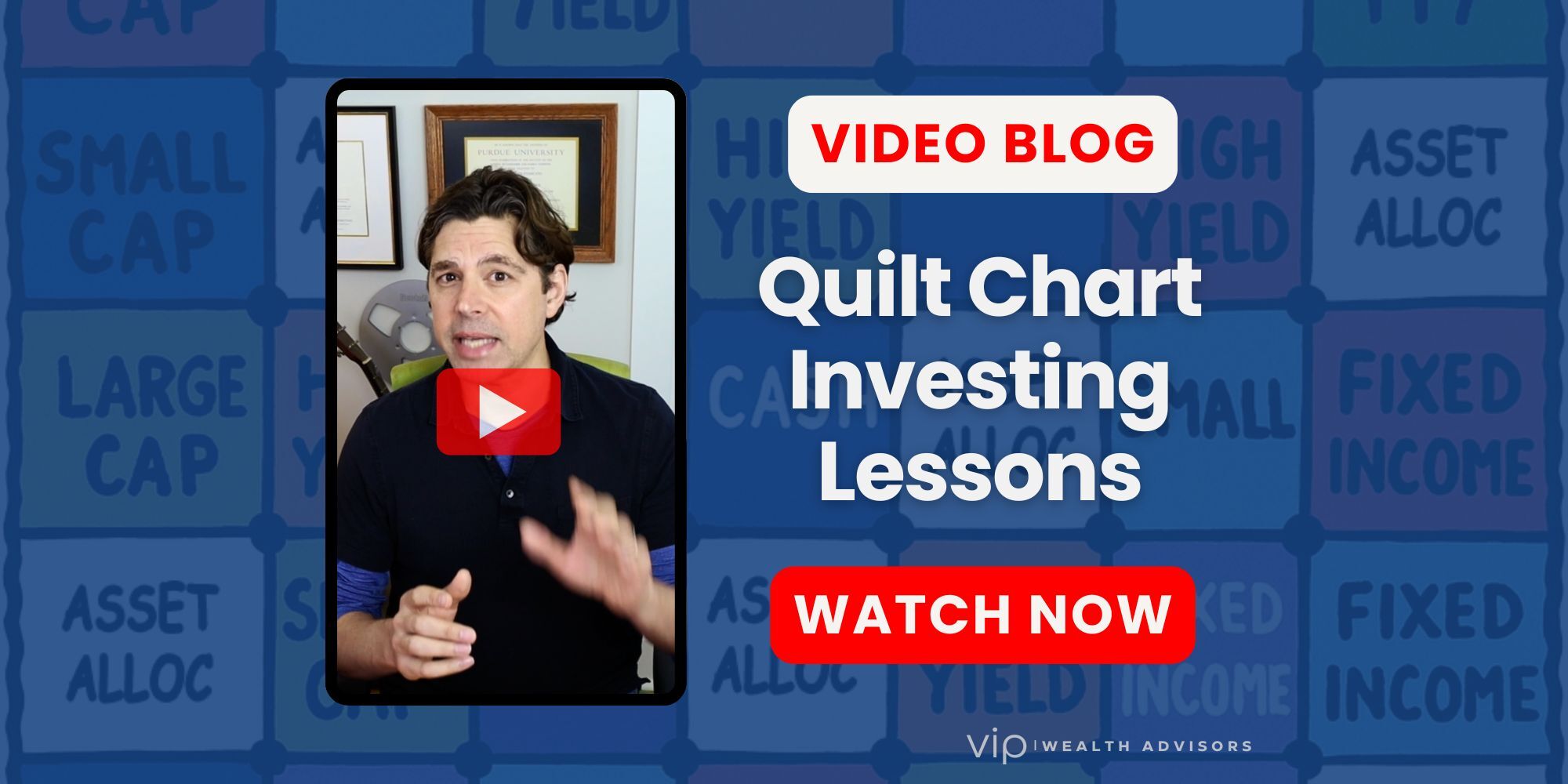When most investors look at the markets, they see a scoreboard. Green means “go,” red means “stop,” and last year’s winners feel like safe bets for next year.
But the data tell a different story; one that can save you from some of the most costly mistakes investors make.
One of the clearest illustrations comes from a simple but powerful visual called the Quilt Chart of Asset Class Returns published by JPMorgan. This chart ranks major asset classes by performance each calendar year, from best to worst, using different colors to make the rotation of leaders and laggards impossible to miss.
And over the last 16 years, from 2009 to 2024, the quilt chart tells us this: market leadership changes constantly, often without warning, and no one asset class stays on top for long.

Lesson 1: There’s No Permanent Champion
From 2009 to 2024, no single asset class dominates the leaderboard for long.
- 2009: Emerging Markets soared +79% after the global financial crisis.
- 2010: U.S. REITs jumped +28%.
- 2011: Bonds led the way as stocks faltered.
- 2020: Small-cap growth crushed it with +20% during the pandemic tech boom.
- 2022: Commodities were the lone winner at +16% while nearly everything else was negative.
The leaders change constantly. What’s hot one year can be ice cold the next. The quilt chart makes this painfully obvious — and that’s the point.
Investor takeaway: If you chase the top performer from last year, you’re often buying high and setting yourself up for disappointment.
Lesson 2: Rotation Is the Rule, Not the Exception
The quilt chart looks like a kaleidoscope. Every year, colors shuffle positions up and down the column.
Even within U.S. stocks, leadership shifts:
- Some years, small caps shine (2013: +39%).
- Other years, large caps dominate (2019: +31%).
- Sometimes, value leads (2021), and sometimes, growth takes the crown (2020).
International stocks have their moments, too — the Eurozone was a star in 2017 (+26%), India in 2023 (+22%).
Investor takeaway: Expect the unexpected. Asset classes don’t move in sync, and their cycles of outperformance can be short and sharp.
Lesson 3: Diversification Smooths the Ride
In the quilt chart, there’s one square that rarely touches the top or bottom — the balanced portfolio (often represented by a 60% stock / 40% bond mix).
From 2009 to 2024, this balanced allocation delivered an annualized return of roughly 7%–8%, without the gut-wrenching swings of the extremes.
It wasn’t flashy. It didn’t grab headlines. But it quietly did its job:
- Participating in up markets.
- Cushioning the blow in down markets.
This is the essence of diversification — not maximizing every year’s return, but minimizing regret over the long term.
Lesson 4: Extreme Years Can Mislead
Some years are so dramatic that they tempt investors to overreact:
- 2009: Coming out of the crisis, emerging markets gained nearly 80% — a once-in-a-generation rebound.
- 2020: Pandemic-fueled tech stocks soared while value stocks lagged badly.
- 2022: Commodities surged on inflation fears, while both stocks and bonds posted double-digit losses.
If you’d reshuffled your portfolio to chase these winners, odds are you’d have been burned within 12 months.
Investor takeaway: One year’s data is a story; ten years’ data is a lesson.
Lesson 5: Long-Term Winners Aren’t Always Steady Climbers
The chart confirms that U.S. large-cap growth (think S&P 500 leaders like Apple, Microsoft, Nvidia) has been an enormous driver of overall equity returns in the last decade.
But even the star pupil has had rough years:
- 2018: –4.4% return
- 2022: –30% drawdown (intra-year)
Long-term winners often endure short-term pain. The only way to capture the multi-year upside is to ride through the occasional ugly year.
Lesson 6: Some Asset Classes Rarely Lead, But Still Matter
Cash, commodities, and certain bond sectors rarely hit the top of the chart. But when they do, it’s usually when everything else is struggling:
- Bonds in 2011 and 2014.
- Commodities in 2021 and 2022.
- Cash (T-bills) is looking competitive again in 2022–2024 as interest rates rose.
Their role isn’t to win every year — it’s to protect and stabilize when risk assets falter.
Lesson 7: Rebalancing Turns Chaos into Opportunity
Here’s where the quilt chart isn’t just interesting — it becomes actionable.
Because asset class performance is cyclical, rebalancing forces you to:
- Trim positions that have become overweight after a big run (selling high).
- Add to positions that have lagged and may be poised for a rebound (buying low).
This is how disciplined investors turn market noise into long-term compounding.
The Data in Context: 2009–2024 Highlights
- Highest single-year return: Emerging Markets in 2009 (+79%).
- Worst single-year return: Commodities in 2015 (–24%).
- Only year both stocks and bonds fell significantly: 2022 — commodities saved the day.
- Most consistent middle performer: Balanced 60/40 portfolio.
Why the Quilt Chart Works as a Teaching Tool
It’s one thing to say “markets move in cycles,” it’s another to see it.
The quilt chart’s jumbled pattern is the perfect antidote to “I’ll just buy whatever did best last year.” It makes the randomness of short-term market leadership impossible to ignore, which is precisely the reminder most investors need before making allocation changes.
The VIP Wealth Advisors Framework for Using This Data
✅ Start with a Core Allocation: Use a diversified mix of global stocks, bonds, and alternatives that matches your risk tolerance.
✅ Tilt, Don’t Swing: If valuations or economic cycles favor certain areas, we tilt exposure — but never abandon diversification.
✅ Rebalance with Purpose: We review client portfolios regularly to trim winners and add to laggards, turning volatility into an advantage.
✅ Stay Tax-Smart: When rebalancing in taxable accounts, we harvest losses where possible and manage gains strategically to minimize your tax bill.
✅ Avoid Performance Chasing: We let the data — not headlines — drive decisions.
The Power of Seeing the Whole Picture
If you zoom in on any one year of the quilt chart, you’ll see noise. If you zoom out over a decade and a half, you’ll see the pattern:
- No single asset class can win consistently.
- Diversification cushions the ride.
- Rotation is inevitable and often unpredictable.
- Long-term discipline beats short-term guessing.
Investing success isn’t about predicting next year’s winner — it’s about building a portfolio that can thrive no matter who’s on top.
At VIP Wealth Advisors, we use tools like the quilt chart to help clients see beyond the noise, focus on their long-term goals, and make decisions based on evidence, not emotion.
Because in the end, markets will always move like a quilt; patchwork, colorful, and constantly changing. Your portfolio’s job is to make sure every patch works together.
🧭 Ready to Build a Smarter, More Resilient Portfolio?
At VIP Wealth Advisors, we help clients turn data into discipline — designing diversified, tax-smart portfolios that thrive through every market cycle. No chasing. No guessing. Just modern strategy built for real life.
📅 Book Your VIP Planning Call
View More Articles by Topic
- Taxes (76)
- Financial Planning (40)
- Equity Compensation (34)
- Investments (23)
- RSU (21)
- Tax Policy & Legislation (18)
- Business Owner Planning (15)
- Incentive Stock Options (14)
- Retirement (14)
- Psychology of Money (10)
- Alternative Investments (9)
- Real Estate (9)
- AMT (8)
- Pre-IPO Planning (8)
- Estate Planning (7)
- Fiduciary Standard (6)
- NSOs (6)
- The Boring Investment Strategy (6)
- Capital Gains Tax (5)
- Crypto (5)
- QSBS (5)
- Post-IPO Tax Strategy (4)
- 401(k) Strategy (3)
- Private Investments (3)
- Q&A (3)
- Charitable Giving (2)
- ETF Taxes (2)
- IRA Strategy (2)
- International Financial Strategies (2)
- Irrevocable Trust (2)
- Legacy Wealth (2)
- Market Insights (2)
- Market Timing (2)
- Stock Market (2)
- Venture Capital (2)
- Video (2)
- AUM vs Flat Fee (1)
- Altruist (1)
- Atlanta (1)
- Book Review (1)
- Depreciation & Deductions (1)
- Education Planning (1)
- Precious Metals (1)
- QTIP Trust (1)
- Revocable Trust (1)
- Schwab (1)
- Solo 401k (1)


.jpg)





